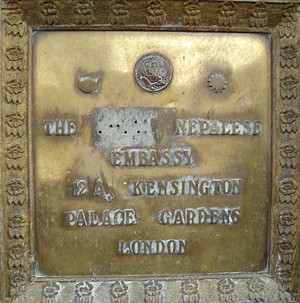Nepal’s embassy building in London is a tangible monument to the country’s independence, selling it would be sacrilege

BLUE RASPBERRY
Nepal’s recent history after the restoration of
democracy in 1990 is littered with wrecked hulks of institutions run to the ground by greedy and incompetent leaders. Political parasites picked on the carcasses of parastatals that they helped kill: Royal Nepal Airlines, Nepal Electricity Authority, Nepal Oil Corporation, Udaypur Cement Factory, Sajha Yatayat … it is a sad and long list.
It’s not that there wasn’t corruption during the 30-year Panchayat regime under an absolute monarchy, but we have amply demonstrated that the state can be much more destructive when political parties compete to plunder. Democracy democratised corruption. Politicians persecuted during authoritarianism felt it was their god-given right to rake it in when they got to power. They didn’t just tarnish their own image, but gave democracy itself a bad name.
In a country without resources, where pickings are so slim, politicians steal anything they can lay their hands on. Bureaucrats were in perpetual rent-seeking mode, kickbacks on aircraft leases was a particular favourite in the 1990s. Scamming petroleum retail was also lucrative and when the conflict began, many profited from the opaque war economy. What remained of the checks and balances of democracy were systematically dismantled in these six years since the ceasefire. Pre-paid appointments to juicy corporations became the norm in coalition politics and the last Maoist-Madhesi government was by the far the most crooked in our history.
For the past 10 years, politicians of different hues have licked their chops greedily at Nepal’s UK embassy in the upscale Kensington Palace Gardens street in London. The building, which is a Crown Estate, was leased to Nepal for 99 years in 1937 when Britain and Nepal formally upgraded their bilateral relations and as a reward for helping out during the First World War. In 1980, the lease was extended for another 99 years under an agreement in which a nominal annual rent is paid.
Nepal’s 12A Kensington Palace Gardens property is today worth at least £150 million and sits on a street which is called ‘Billionaire's Boulevard’ and houses other diplomatic residences and mansions. Two of them belong to the fourth richest man in the world, Lakshmi Mittal. Ten years ago, the Mittals made an offer to our rulers and the embassy would have been sold off had there not been a hue and cry. Talk of the embassy sale had died out until earlier this year, when it mysteriously surfaced again under foreign minister Narayan Kaji Shrestha.
There are many reasons why selling off the embassy is a bad idea, prominent among them is the fact that it is a tangible monument to the bloodshed by tens of thousands of Nepalis in 20th century wars. The British did not give the palace to the Ranas, but to Nepali people. It was our first embassy abroad and its worth cannot be measured in monetary terms. To say that all Nepalis have a sentimental attachment to the embassy building would be an understatement.
But the real reason why the embassy should not be sold now is because our record for accountability and transparency during this messy and prolonged political transition is so tainted that the transaction is sure to be accompanied by massive fraud. Which is why there is such outrage among Nepalis in Britain who have formed a Save Our Embassy Building Citizen’s Campaign (see story on page 4).
The Supreme Court’s stay order this week on a writ filed by a Gurkha veteran’s association is a small victory in the long struggle to save the embassy from a highly suspect deal. But it only buys us time to restore democracy and political accountability at home so that 12A doesn’t become yet another victim of greedy rulers who have ruined this country.
Read also:
Here and now